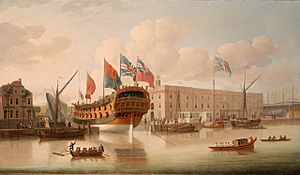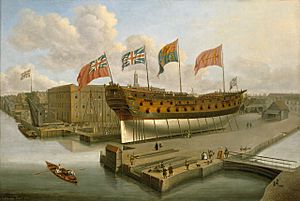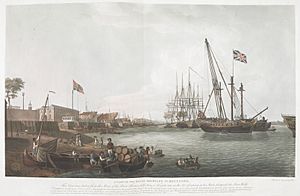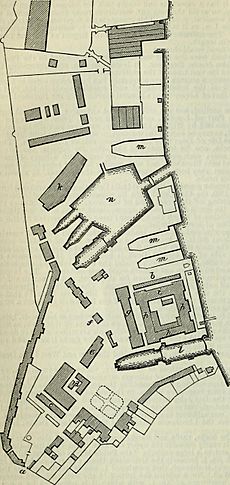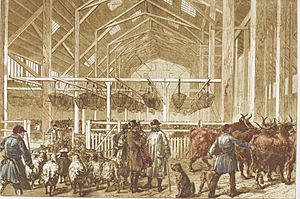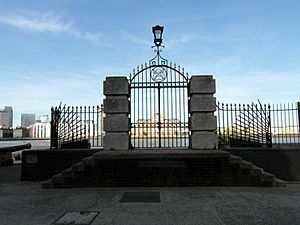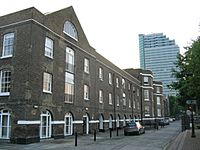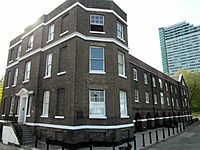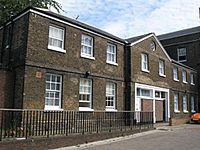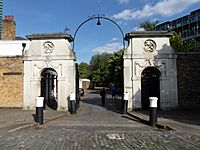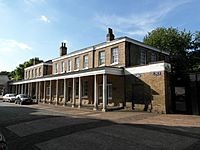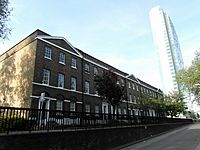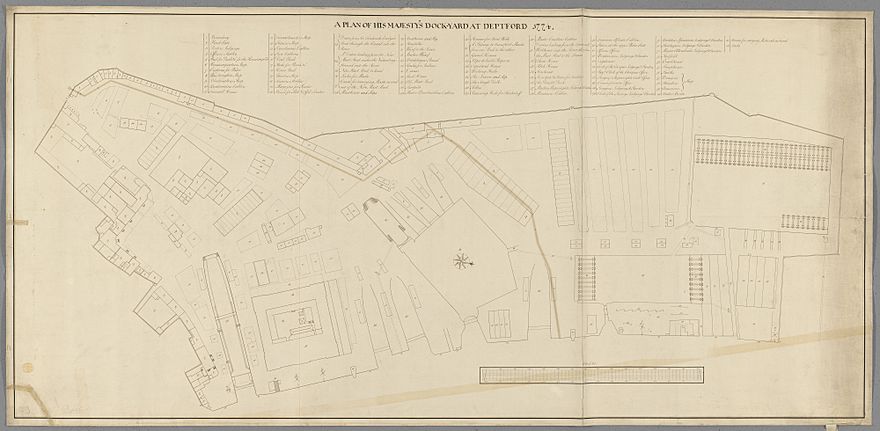Deptford Dockyard facts for kids
Quick facts for kids HM Dockyard, Deptford
|
|
|---|---|
| Deptford, NW Kent | |
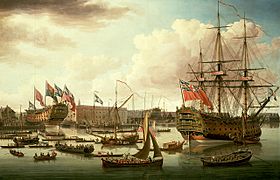
The yard in its heyday. The launch of the 80-gun HMS Cambridge from the Great Dock in 1755, depicted by John Cleveley the Elder. In the foreground a first rate warship rides at anchor, while another warship nears completion on the slipway in the centre background.
|
|
| Coordinates | 51°29′11″N 0°1′39″W / 51.48639°N 0.02750°W |
| Site information | |
| Operator | Royal Navy |
| Controlled by | The Navy Board (until 1832); the Admiralty (1832–1869). |
| Other site facilities |
The Victualling Yard and Transport Board office. |
| Site history | |
| In use | 1513–1869 |
Deptford Dockyard was a really important place for the Royal Navy in England. It was located in Deptford on the River Thames. For over 350 years, from the 1500s to the 1800s, this dockyard built and repaired warships. Many famous ships and events in British history are connected to it.
King Henry VIII started the dockyard in 1513. It quickly became the most important royal dockyard during the Tudor period. It stayed one of the main naval yards for three centuries. New ideas for shipbuilding and how to organize the navy were tested here. Great explorers like Francis Drake and Walter Raleigh were also linked to Deptford.
The dockyard grew a lot in the 1500s and 1600s. For a while, it was even the main office for the navy's leaders. The nearby Victualling Yard became the main place for storing food and supplies for the navy. In 1698, Peter the Great, the Tsar of Russia, secretly visited the yard to learn about shipbuilding.
Deptford Dockyard was at its busiest in the 1700s. It built and fixed ships for famous explorers like Captain Cook, Vancouver, and Bligh. Warships that fought under Admiral Nelson were also built or refitted here.
After the Napoleonic Wars ended, the dockyard became less important. It was hard for the big new warships to reach Deptford because the River Thames was too shallow and narrow. After 1830, the dockyard was mostly quiet. Although shipbuilding started again for a short time in the 1840s, the navy finally closed the yard in 1869. The victualling yard, which supplied food, stayed open until the 1960s. Today, the area where the dockyard once stood is known as Convoys Wharf.
Archaeologists dug up parts of the dockyard between 2010 and 2012 to learn more about its past.
Contents
History of Deptford Dockyard
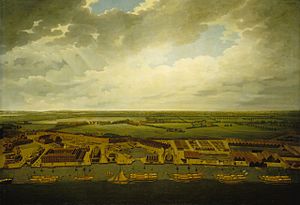
How the Dockyard Started
People had been building royal ships in the Deptford area since the early 1400s. This was during the time of King Henry V. Later, King Henry VII rented a storehouse in Deptford in 1487. He then started the first royal dockyard at Portsmouth in 1496.
His son, King Henry VIII, wanted to expand the navy even more. He preferred locations along the Thames River. So, he set up Woolwich Dockyard in 1512. Then came Deptford in 1513 and Erith in 1514. These new dockyards had large storehouses to support the navy during the War of the League of Cambrai.
The Tudor Dockyard (1500s)
Deptford's 'Great Store-house' was built in 1513. It was a two-story brick building, about 52 meters (172 feet) long and 10 meters (35 feet) high. It stood next to the river. The Great Dock, a long dry dock for repairing ships, was built around the same time.
In 1517, a natural pond was turned into a wet dock. This basin gave a safe place for the King's ships to anchor. Deptford grew as the navy's management became more organized. In the 1540s, a large house was built for the Treasurer of the Navy. Another house was built for the navy's clerks.
Deptford became the most important royal dockyard. It hired more and more workers and added new storehouses. Its importance meant that the king would sometimes visit to see new ships. In 1550, money was spent to pave Deptford High Street. It had been "full of filth" and hard for the King to pass.
By the end of the 1500s, the dockyard was known as the "King's Yard." It had wharves covering 150-180 meters (500–600 feet) of the riverfront. In 1578, gates were added to the dry dock. This made it easier to get ships in and out.
Deptford's importance to England's sea power was clear when Queen Elizabeth I knighted Francis Drake there in 1581. This was after he sailed around the world on the Golden Hind. She ordered the Golden Hind to be kept in Deptford Creek for people to see. The ship stayed there until the 1660s. Deptford is also linked to the story of Sir Walter Raleigh laying his cloak down for the Queen. Because of its big role, Deptford was called the "Cradle of the Navy."
Stuart Expansion (1600s)
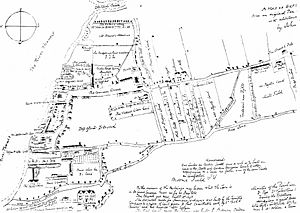
Other shipyards, like Chatham Dockyard, started to become more important. By the early 1600s, people even talked about closing Deptford. The Thames was too narrow and shallow for the growing navy's big ships. So, attention moved to places like Chatham and Sheerness.
But Deptford Dockyard still grew. It was closely linked to the Pett dynasty, a family that produced many master shipbuilders. In the 1620s, a navy committee decided to focus shipbuilding at Deptford. They ordered many new ships to be built there. By the 1600s, the yard was very large. It had many storehouses, slipways (where ships are built), and workshops. The Great Dock was made longer and wider in 1610. A second dry dock was built in 1620, and a third was approved in 1623.
More money was invested during the Commonwealth period. A mast dock and three new wharves were added. After the Glorious Revolution of 1688, facilities were improved again. A 'Great New Storehouse' was built. By the end of the century, new buildings created a courtyard. Houses for the yard's officers were also built.
Peter the Great, the Tsar of Russia, visited the yard in 1698. He stayed nearby at Sayes Court. Peter studied shipbuilding techniques at the dockyard. The Great Dock was rebuilt again in 1711. It was given gates in the middle to make it a 'double dock', able to hold two ships.
Early Georgian Flourishing (1700s)
The early to mid-1700s was a time of major rebuilding at Deptford. The storehouse area was rebuilt into a formal courtyard. The mast pond and wet dock were rebuilt. The smithy, where metal items like anchors were made, was made larger. In 1716, another dry dock was added.
Deptford focused on building smaller warships. It also became the main office for the naval transport service. During the wars of the 1700s and 1800s, the navy used river docks like Deptford for building ships. This left the main bases like Portsmouth for repairs.
Because it was close to the Navy Board offices, Deptford also worked on new and experimental ship designs. In the 1750s, the first of a new type of 74-gun warships were built here. In the 1760s and 1770s, tests were done on covering ships' hulls with copper. This was to stop Teredo worms from damaging the wood. Experiments also looked at turning seawater into drinking water.
The yard grew northwards in the 1770s. This allowed for a second, larger mast pond and a sixth shipbuilding slip. A report in 1774 said that both large and small ships were built at Deptford. Large ships could be launched, but they had to be moved downriver quickly. Smaller ships like frigates could be repaired and equipped at Deptford.
Many famous ships and people are linked to Deptford. Several ships used by James Cook for his voyages were refitted here. These included HMS Endeavour, HMS Resolution, and HMS Discovery. Ships used by George Vancouver on his expedition were also refitted. HMS Bounty was refitted in 1787, and HMS Providence (used by William Bligh) was too. Warships built here include HMS Neptune and HMS Colossus. These ships fought under Nelson at the Battle of Trafalgar.
Late Georgian Decline (1800s)
After the Napoleonic Wars, there was a long period of peace. This meant the navy needed fewer new ships and less repair work. Deptford's location on the shallow Thames made things worse. Work moved to other royal dockyards. Engineer John Rennie noted that large ships built at Deptford had to be taken to Woolwich to be fully prepared.
On January 31, 1821, the navy ordered that only small repairs could be done at Deptford. However, Deptford was still used for new ideas. In 1822, HMS Comet, the Royal Navy's first steam-powered ship, was launched there. In 1827, the dockyard became smaller. The mast pond and mast houses were given to the victualling yard.
The dockyard was mostly closed between 1830 and 1837. Only old ships were broken up there. The navy kept one ship under construction to meet a lease agreement.
Victorian Rebuilding (Mid-1800s)
The dockyard reopened for shipbuilding in 1844. Small warship construction continued for 32 more years. Ships launched at Deptford were then finished at Woolwich Dockyard. The Great Dock was rebuilt from 1839 to 1841 and covered with a timber roof. From 1844 to 1846, the old shipbuilding slips were completely rebuilt. Some of the new slips were covered with timber or cast iron roofs.
In 1856, the navy bought the nearby Sayes Court estate to make the dockyard bigger. In 1860, they hoped to start building larger ships. But when ironclad warships were introduced, it became clear that Deptford Dockyard's time was ending. In 1865, a committee suggested closing the yard for shipbuilding.
Closure (1869)
Deptford Dockyard was closed on March 31, 1869. The screw corvette HMS Druid, launched on March 13, 1869, was the last ship built there.
Even after closing as a building yard, part of the site stayed open as a naval store depot. It was used to send naval supplies to other places around the world. Some manufacturing, like making sails, continued into the 1880s. By the mid-1890s, this store yard was combined with the nearby Royal Victoria Victualling Yard. In 1898, the naval stores moved to new warehouses. The Victualling Yard then expanded into the old dockyard area.
After the Dockyard Closed
After the dockyard closed, most of its land was sold. Fifteen acres were sold back to William John Evelyn. He wanted to turn it into a public park. He planted trees and added a bandstand and a museum. But he couldn't find a public group to take care of the park. This helped inspire his friend Octavia Hill to start the National Trust.
Foreign Cattle Market
The rest of the land, about 12 hectares (30 acres), was bought by the City of London Corporation. It was quickly turned into the Foreign Cattle Market. This market was for selling and slaughtering imported animals. The old slips and docks were filled in. The sheds over them were joined and made into pens for 4,000 cattle and 12,000 sheep. Many slaughterhouses were set up. The market opened on December 28, 1871.
Supply Reserve Depot
The Cattle Market closed in 1913. In October 1914, the land was leased by the War Department. It became a Supply Reserve Depot (SRD) for the Army Service Corps. This was a central place to store and send food and supplies to soldiers overseas. During the First World War, more space was needed. The War Department took over most of the public parkland. The Depot and Victualling Yard were attacked by a zeppelin in 1915. In 1924, the War Office bought the land.
In the mid-1930s, Deptford was the Army's only Supply Reserve Depot. It was very open to air attacks. Other depots were built, but Deptford stayed open. It was badly damaged by bombs during the Second World War. Seven V1 Flying Bombs hit the area in 1944, and a V2-rocket hit in 1945.
After the Royal Victoria Victualling Yard closed in 1961, the Navy kept a small part of the land. It became a Royal Naval Store Depot (RNSD Deptford). This depot handled naval freight and stored stationery, furniture, and other items. It also had garages for naval vehicles. The RNSD closed in 1984.
What Happened to the Site
In 1984, the site was sold to Convoys Ltd, a company that imported newsprint. It became known as Convoys Wharf. Later, News International took it over and used it for storing paper. In 2012, they left the site. Now, the area is planned to be redeveloped into homes.
Legacy of Deptford Dockyard
Many of the dockyard's buildings and features survived until the 1950s. But most have since been lost or destroyed. The waterways have been filled in. Henry VIII's Great Storehouse from 1513 was torn down in 1954. Its bricks were used to repair Hampton Court Palace. Other storehouse buildings were demolished in 1984.
However, a few buildings still stand. These include the Master Shipwright's House from 1708 and the nearby Office Building from 1720. The Olympia Warehouse from 1846, with its unique iron structure, also survived. It was originally a double shed built over slipways for covered shipbuilding.
Also, the remains of many important features are still underground. These include slipways, dry docks, basins, and building foundations. Archaeologists have studied them. The underground remains of the Tudor Great Storehouse are now a Scheduled Ancient Monument.
The Lenox Project
In 2013, the Lenox Project proposed building a full-size sailing replica of HMS Lenox. This 70-gun warship was originally built at Deptford Dockyard in 1678. The plan is to build the replica on the dockyard site. It would be the main attraction of a new museum. This museum would be a permanent part of the Convoys Wharf development.
By late 2015, the project gained support. More detailed plans showed how building the Lenox would fit into the area's development. It is hoped that the Lenox will help bring new life to Deptford. Just like the replica ship Hermione did for Rochefort in France.
The Victualling Yard
In the 1600s, a Victualling Yard was set up next to the main dockyard. Its job was to supply food and other provisions to the navy's warships. In 1743, the Victualling Commissioners decided to move their main depot to Deptford. They built new facilities, including a cooperage (for making barrels), storehouses, slaughterhouses, and places for baking and brewing. After some fires, the yard was completely rebuilt in the 1780s. In 1858, it was renamed the Royal Victoria Victualling Yard.
This yard supplied ships in the Thames and Medway rivers. It also served as the main supply and manufacturing center for other Victualling Yards in Britain and overseas.
The Royal Victoria Victualling Yard stayed open for almost a century after the dockyard closed. It continued to make and store food, drink, clothing, and furniture for the navy. It closed in 1961, and a council estate was built on the site. Many of its buildings and features from the 1770s-1780s still exist today.
- Surviving buildings and structures of the Victualling Yard
The Transport Yard
The Commissioners of the Board of Transport had their main office in Westminster. But they also had an office at Deptford. This office was very important for managing the transport of goods. It arranged ships for the Army, Navy, and other groups. These ships carried troops, horses, supplies, and weapons overseas. The Transport Office found ships, hired crews, and made sure everything was loaded and ready.

Most of the ships needed by the Transport Board were rented. The contract usually said they had to come to Deptford first. Here, the Board's representatives would inspect them. The Deptford office had a Resident Agent, an Inspecting Agent, a Shipwright Officer, and a Storekeeper. They worked closely with the Dockyard's officers. They inspected ships and prepared them for service. The Resident Agent sent daily updates to the Transport Board in Westminster.
By 1800, the Transport Board was renting space at Dudman's Dock. This included a storehouse, wharf, and offices. They also used the dock, which was a large basin connected to the Thames. This allowed transport ships to load supplies directly. In 1828, it was announced that the Royal Dockyard would become a transport yard and a storage depot. The Transport Agent and his staff moved to the nearby dockyard.
Later, the Resident Transport Officer was housed in the Victualling Yard. By 1860, the Transport Establishment, Dockyard, and Victualling Yard were all managed by the Captain-Superintendent.
Plan of the Georgian Dockyard



